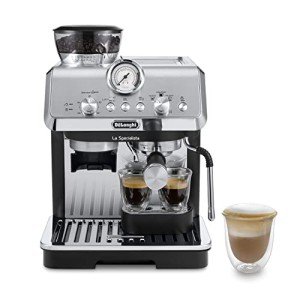The No. 1 Question That Anyone Working In Italian Espresso Machines Needs To Know How To Answer
Heat Exchange Espresso Machines: A Comprehensive Guide
Espresso machines have actually progressed substantially throughout the years, catering to the requirements of home baristas and coffee professionals alike. Amongst these machines, heat exchange espresso machines have actually gained appeal due to their ability to deliver constant efficiency and remarkable brew quality. In this article, we will check out the workings, benefits, and essential functions of heat exchange espresso machines, providing a comprehensive understanding for both prospective purchasers and coffee lovers.
Understanding Heat Exchange Technology
Heat exchange espresso machines operate on a distinct concept that enables synchronised water heating for brewing and steaming. link homepage are equipped with a single boiler that uses a heat exchanger system. This function is considerable as it allows users to brew espresso while steaming milk simultaneously, promoting efficiency in the coffee-making process.
How Does a Heat Exchange Espresso Machine Work?
The procedure begins with the machine's water inlet filling the boiler. As the water warms up, it turns to steam. The ingenious heat exchanger utilizes hot steam to heat extra water in a different passage designed particularly for the brew group. Online Espresso Machines Store means that water can reach the perfect developing temperature level without waiting for the boiler to adjust. The essential steps consist of:
- Water Fill: Water is drawn into the boiler.
- Heating Process: The boiler warms up as water is converted into steam.
- Heat Exchange: Steam heats water in the heat exchanger tube.
- Brewing: Water from the heat exchanger is pushed through coffee premises, drawing out the tastes needed for a rich espresso.
This process enables quick temperature modifications and enhanced coffee extraction.
Advantages of Heat Exchange Espresso Machines
Heat exchange espresso machines offer several advantages, particularly for those looking to maximize their coffee experience. Here are some crucial advantages:
- Simultaneous Brewing and Steaming: Users can brew espresso while steaming milk, making it ideal for hectic cafes and home baristas who value performance.
- Temperature Stability: The boiler's steam pressure helps keep a steady temperature, which is important for consistent espresso extraction.
- Versatility: The design permits fast switching between brewing and steaming, making it simpler to develop numerous coffee beverages, from lattes to cappuccinos.
- User-friendly: Models often include available controls, making it feasible for both beginners and knowledgeable baristas to produce quality beverages.
- Professional Quality: Heat exchange machines are frequently used in commercial settings, supplying users with high-quality developing performance in the house.
Key Features to Look for in Heat Exchange Espresso Machines
When thinking about the purchase of a heat exchange espresso machine, there are a number of features that a person ought to take into account:
- Build Quality: Look for machines made from resilient materials, such as stainless-steel or brass, ensuring durability.
- Boiler Size: A larger boiler will hold more water and sustain higher output over time.
- PID Temperature Control: This feature helps maintain constant brew temperatures, which can enhance the coffee-making process.
- Group Head Design: Machines with a saturated or semi-saturated group head supply better temperature stability.
- Relieve of Use: User-friendly interfaces and instinctive controls improve the overall experience for baristas at all skill levels.
- Steam Wand Quality: A good steam wand with appropriate insulation and flexibility enables for better texturing of milk.
- Water Reservoir Size: Depending on your needs, consider how frequently you wish to fill up the water tank.
Contrast of Popular Heat Exchange Espresso Machines
To better comprehend the choices readily available in the market, below is a contrast table of some popular heat exchange espresso machines:
Machine Model
Boiler Size
PID Control
Rate Range
User Ratings
Profitec Pro 700
2.0 L
Yes
₤ 2,000-₤ 2,500
9.5/ 10
Rocket Espresso R58
1.8 L
Yes
₤ 2,400-₤ 2,800
9.4/ 10
Elekta Bianca
1.8 L
Yes
₤ 2,500-₤ 3,000
9.6/ 10
La Spaziale S1 Vivaldi II
1.5 L
Yes
₤ 1,800-₤ 2,200
9.2/ 10
Bezzera Magica
1.2 L
No
₤ 1,600-₤ 1,800
9.0/ 10
Frequently Asked Questions About Heat Exchange Espresso Machines
What is the main difference between a heat exchange and a dual boiler espresso machine?
While both types can brew espresso and steam milk at the exact same time, dual boiler machines have different boilers for brewing and steaming. In contrast, heat exchange machines make use of a single boiler and a heat exchanger to achieve the same function.
Are heat exchange machines appropriate for novices?
Yes! Lots of heat exchange machines are developed with user-friendly functions, making them accessible for novices. With correct assistance and practice, users can quickly produce quality espresso.
What type of upkeep do heat exchange espresso machines require?
Regular maintenance includes descaling, cleaning up the boiler, inspecting seals and gaskets, and keeping the group head clean. Regular maintenance makes sure longevity and consistent efficiency.
Can I use a heat exchange machine for various types of coffee beverages?
Definitely! Heat exchange machines permit users to create a variety of coffee drinks, consisting of espresso, lattes, coffees, and more.
Heat exchange espresso machines represent a blend of innovation and tradition, offering coffee enthusiasts with the tools needed for crafting the best cup. Their ability to concurrently brew and steam, integrated with accurate temperature control, makes them a compelling choice for both home baristas and experts. With the right understanding on features and upkeep, users can open a world of exquisite coffee experiences, making sure that each sip is as delightful as the last.
